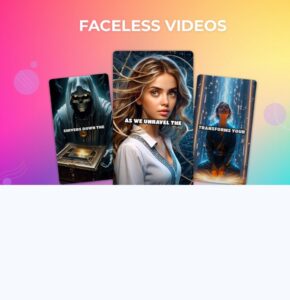In the evolving landscape of digital content creation, one intriguing trend that’s gaining momentum is the production of faceless videos. This approach, which avoids showing the creator’s face, is revolutionizing the way content is made and consumed online. It caters to creators who prefer to maintain their privacy or who want to focus more on the content itself rather than the personality presenting it. In this blog, we’ll delve into how faceless videos are changing the online content creation scene and explore the tools, techniques, and benefits of this innovative approach.

The Rise of Faceless Videos
Faceless videos have emerged as a powerful medium in the content creation world. This trend can be seen across various platforms, including YouTube, TikTok, and Instagram, where creators produce engaging videos without revealing their identities. The reasons behind this approach are manifold. Some creators are camera-shy or wish to keep their personal lives private. Others find that a faceless format allows them to produce content more quickly and efficiently, as it reduces the need for personal grooming and elaborate setups. Moreover, faceless videos often shift the focus from the creator to the content, which can enhance the educational or entertainment value of the video.
Techniques for Creating Effective Faceless Videos
Creating compelling faceless videos involves several techniques that ensure the content remains engaging and informative. Here are some strategies:
Voiceovers: Utilizing voiceovers is a common technique where the creator narrates the content, providing personal insights or explanations without appearing on screen. This method is particularly popular in tutorial videos, storytelling, and product reviews.
Screencasts: For educational or technical content, screencasts are incredibly effective. This technique involves recording the computer screen while narrating the actions. It’s ideal for software tutorials, presentations, or any content that focuses on digital products or services.
Animation and Motion Graphics: Animation is a versatile tool for faceless videos, allowing creators to convey complex stories or concepts in an engaging way. Whether it’s simple whiteboard animations or fully animated characters, this technique can capture the audience’s attention and make the content memorable.
Text and Subtitles: Some faceless videos rely heavily on written text and subtitles to communicate their message. This style is especially prevalent in short-form content on platforms like TikTok or Instagram, where quick, catchy text-based videos can go viral.
Tools for Creating Faceless Videos
Make videos without showing your face or needing fancy gear. The faceless video generator turns your text into YouTube videos fast. Just type your ideas, and it does the rest: writes scripts, makes scenes, adds voiceovers and subtitles, and edits everything with easy text commands. Many accessible tools can help creators produce high-quality content:
Screen Recording Software: Tools like OBS Studio, Camtasia, or ScreenFlow enable creators to capture their computer screens and include voiceovers with ease.
Animation Software: Programs like Adobe After Effects, Animaker, or Blender are great for creating animations ranging from simple to complex, depending on the creator’s skill level.
Video Editing Software: For compiling and refining faceless videos, video editing software like Invideo AI, Adobe Premiere Pro, Final Cut Pro, or even more user-friendly options like iMovie or Filmora can be used.
Benefits of Faceless Videos
The appeal of faceless videos extends beyond the simplicity of their production. Here are several benefits:
Privacy and Anonymity: Creators can maintain a private life and avoid the pitfalls of online fame, which can include harassment or unwanted attention.
Focus on Content Quality: Without the need to present a face, creators can invest more time and resources into researching, scripting, and editing their videos to ensure the content itself is of high quality.
Inclusivity: Faceless content is judged solely on the value it provides, not on the appearance or on-screen charisma of the creator, which can make the content more universally relatable.
Scalability: Faceless videos can be easier to produce in volume, especially for creators who use scripts or voice synthesis tools, enabling more consistent content output.
Challenges and Considerations
Despite the advantages, faceless video creators face certain challenges. These include building a personal connection with the audience, which can be more difficult without a physical presence. Additionally, depending on the niche, the absence of a personal touch can sometimes make the content feel less engaging or trustworthy.
Conclusion
Faceless videos represent a transformative shift in the world of online content creation. They offer a unique blend of anonymity, efficiency, and focus that appeals to a wide range of creators and audiences. As digital platforms continue to evolve, the trend of faceless videos is likely to grow, reshaping how content is created and consumed. For anyone looking to start in content creation or seeking to pivot their current strategies, considering the faceless video format might just be the key to success in a crowded digital landscape.
